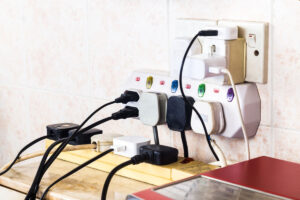- Services
- All Residential Services
- All Commercial Services
- Project Management
- Project Library
- About Us
- Contact

A circuit overload happens when more electricity than your circuit can handle is introduced to the system. An electrical circuit has a safety feature to prevent circuit overload that cuts off electricity when it reaches dangerous levels. When overload protection is triggered, the circuit breaker trips and opens, cutting off the power supply to the unit.
Estimates show that over 40,000 residential fires are caused by overloading electrical circuits every year in the United States. Causes include arc faults, short circuits, and overloading of electrical circuits.
To prevent and minimize the risk of an overloaded circuit, learning the various signs of a potential electrical overload can help. Another important step is to learn which circuits power what areas and devices in your home. If your living room lights dim when you turn the television on, it’s likely they’re on the same circuit, which may be close to maxing out the power load. The visible health of wall plates and outlet covers is also a strong indicator of a potential overload. While outlet covers are designed to protect you from the electrical wiring within, they can only withstand a certain amount of heat.
While the most obvious sign of a circuit overload is when a circuit breaker trips, there are other common indicators. Here are eight common signs of a potential circuit overloaded:
If you notice any of these signs in your home, you should immediately contact us to assess your electronics and ensure there is no dangerous electrical overload.
Fill out this contact form and we'll get back to you!